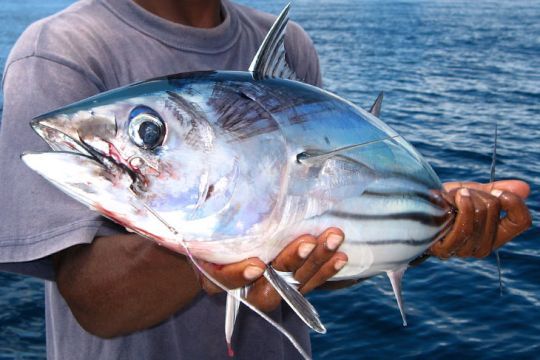If you’re a seafood lover, chances are you’ve heard of tuna. But have you ever come across listao tuna? This lesser-known variety is making waves in culinary circles for its unique flavor and impressive health benefits. With the right knowledge, cooking techniques, and storage tips, you can elevate your meals and incorporate this delicious fish into your diet.
In this guide, we’ll dive deep into everything there is to know about listao tuna—from its nutritional perks to how it compares with other types of tuna. Whether you’re an experienced chef or just starting out in the kitchen, there’s something here for everyone. So grab your apron and let’s explore the wonderful world of listao tuna!
What is Listao Tuna?
Listao tuna, often called skipjack tuna, is a popular species found in warm tropical and subtropical waters. Known for its streamlined body and distinctive dark blue top with silver stripes, it plays a significant role in marine ecosystems.
This versatile fish is smaller than other tuna varieties like yellowfin or bluefin. It typically weighs between 10 to 30 pounds, making it an accessible catch for both commercial fisheries and recreational anglers.
What sets listao apart is its flavor profile. The meat has a rich taste that’s slightly stronger than lighter tunas but milder compared to the more robust bluefin. Its firm texture makes it ideal for grilling, canning, or sashimi preparations.
Due to its abundance in various oceans, listao tuna remains an economical choice for seafood lovers worldwide. Sustainable fishing practices are crucial to maintaining healthy populations of this beloved fish species.
Nutritional Benefits of Listao Tuna
Listao tuna is a powerhouse of nutrition, making it an excellent choice for health-conscious eaters. This fish is rich in high-quality protein, which supports muscle growth and repair.
Packed with essential omega-3 fatty acids, listao tuna promotes heart health by reducing inflammation and lowering cholesterol levels. These healthy fats are also crucial for brain function.
Moreover, listao tuna provides important vitamins and minerals such as vitamin D and selenium. Vitamin D helps regulate calcium levels while supporting immune function. Selenium acts as an antioxidant that protects your cells from damage.
With its low calorie content but high nutrient density, incorporating listao tuna into your diet can contribute to weight management without sacrificing flavor or satisfaction. It’s a guilt-free option that delivers on both taste and nourishment.
Differences between Listao Tuna and Other Types of Tuna
Listao tuna, also known as skipjack tuna, stands out in the vast ocean of tuna varieties. One major difference is its size. Listao tends to be smaller than bluefin and yellowfin tunas, making it more abundant.
The flavor profile is another distinguishing factor. While bluefin offers a rich, buttery taste due to its high-fat content, listao has a lighter and slightly stronger flavor that appeals to many palates.
When it comes to texture, listao features a firmer consistency compared to the more tender yellowfin. This quality makes it an excellent choice for grilling or canning.
Nutritionally, listao tuna contains higher levels of omega-3 fatty acids in some cases but generally has lower mercury levels than larger species like albacore or bigeye. This aspect makes it a safer option for regular consumption without compromising on health benefits.
How to Purchase and Store Listao Tuna
When purchasing listao tuna, freshness is key. Look for vibrant color and firm flesh. Avoid any fish that appears dull or has a strong odor. If buying from a market, don’t hesitate to ask the fishmonger about its source.
Consider whether you want fresh or frozen options. Fresh listao tuna should be consumed within two days of purchase for optimal taste and texture. Frozen varieties can last longer but check packaging dates carefully.
Storing your listao tuna properly extends its shelf life. For fresh fish, wrap it tightly in plastic wrap or place it in an airtight container before refrigerating. Ideally, keep it on ice to maintain low temperatures.
If you’ve chosen frozen listao tuna, store it in the coldest part of your freezer and consume within three months for best quality. Always thaw seafood safely by transferring it to the fridge overnight rather than using hot water or microwaving directly.
Popular Ways to Prepare and Cook Listao Tuna
Listao tuna is incredibly versatile in the kitchen. One popular method is grilling, which enhances its rich flavor while giving it a lovely char. Simply marinate the fish in olive oil, lemon juice, and herbs before placing it on a hot grill.
Seared listao tuna steaks are another favorite. A quick sear creates a crispy exterior while keeping the inside tender and juicy. Pair this with sesame seeds for an extra crunch.
For those who enjoy raw preparations, sushi or sashimi showcases the fresh taste of listao tuna beautifully. Thinly sliced and served with soy sauce and wasabi, it’s a delicacy that brings out its natural flavors.
Incorporating listao tuna into salads can elevate your meal. Tossed with mixed greens, avocado, and a zesty vinaigrette makes for a refreshing dish full of nutrients and taste.
Potential Health Risks and Precautions with Listao Tuna
While listao tuna is a nutritious choice, it’s essential to be mindful of potential health risks. One concern is mercury exposure. Like many large fish, listao tuna can accumulate mercury over time. Consuming high amounts may lead to toxicity.
Pregnant women and children should be particularly cautious regarding their intake. It’s advisable for these groups to limit consumption or choose lower-mercury alternatives.
Another aspect to consider is the sustainability of your source. Overfishing poses threats to tuna populations and marine ecosystems. Opting for sustainably sourced listao tuna helps protect our oceans.
Always ensure proper cooking methods are followed as well. Raw or undercooked fish can harbor parasites or bacteria that might cause illness.
Awareness and responsible choices go a long way in enjoying this tasty seafood while minimizing any associated health risks.
Conclusion:
Listao tuna, often referred to as skipjack tuna, holds a special place in the culinary world. This versatile fish is not only delicious but also packed with nutritional benefits that can enhance your diet. By understanding its unique qualities and learning how to prepare it properly, you can enjoy its flavors while reaping health advantages.
When exploring listao tuna versus other types of tuna, the differences become evident. Its firm texture and distinct taste set it apart from varieties like yellowfin or bluefin. Knowing these distinctions can help you make informed choices for your meals.
Purchasing fresh listao tuna requires attention to quality indicators such as color and smell. Proper storage is crucial to maintain freshness and flavor until you’re ready to cook it. With various preparation methods ranging from grilling to searing, there’s no shortage of ways to enjoy this delectable fish.
While enjoying listao tuna comes with many perks, it’s wise to be aware of potential health risks associated with mercury content in larger species of fish. Being mindful about sourcing and consumption frequency will ensure that you continue benefiting from this nutritious seafood without concern.
Whether you’re a seasoned chef or just starting out in the kitchen, incorporating listao tuna into your meals promises an exciting culinary adventure filled with rich flavors and wholesome nutrition!





